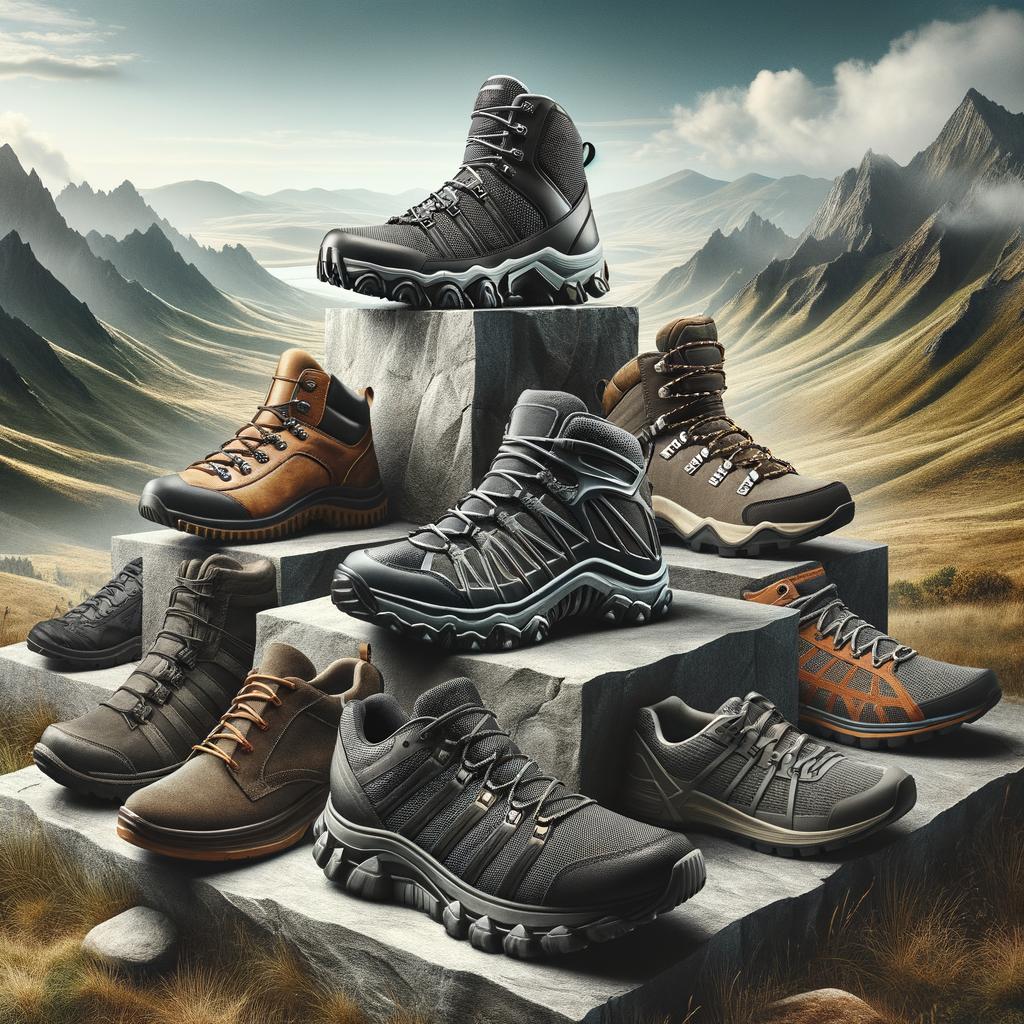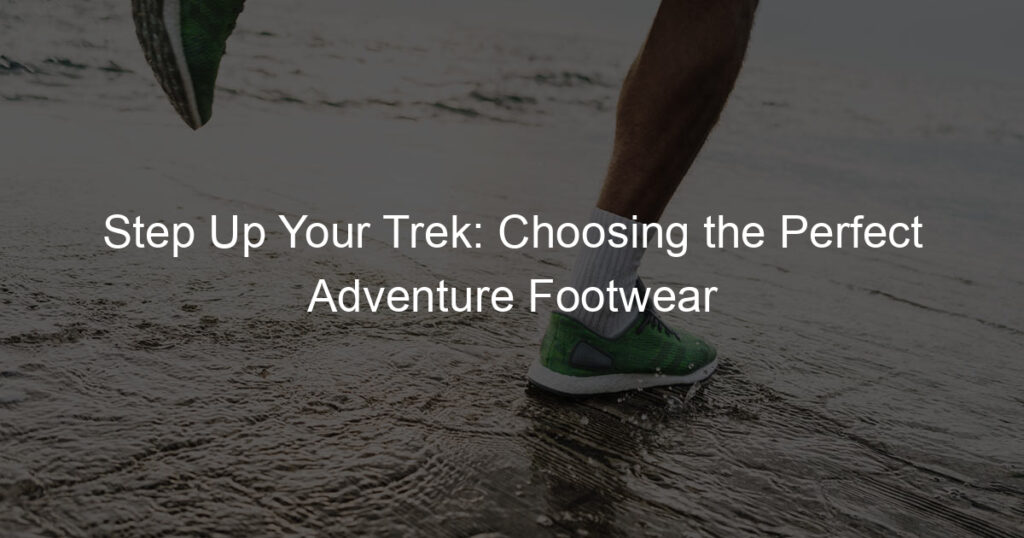
Introduction: The Importance of Choosing the Right Trekking Footwear
When it comes to trekking, one of the most important decisions you’ll make is what to wear on your feet. The right footwear can make the difference between a memorable adventure and a painful ordeal. In this guide, we’ll explore why choosing the right trekking footwear is crucial and how the wrong choice can affect your trek.
- Why the right footwear matters for trekking
- How the wrong shoes can affect your trek
The right footwear can enhance your trekking experience in several ways. First, it provides the necessary grip and traction to navigate through different terrains, from rocky paths to muddy trails. Second, it offers support to your feet and ankles, reducing the risk of injuries. Lastly, good trekking shoes are designed to keep your feet comfortable and dry, regardless of the weather conditions.
On the other hand, the wrong footwear can turn your trek into a nightmare. Shoes that don’t fit properly can cause blisters and sores, making every step painful. Inadequate support can lead to sprains or even fractures. Furthermore, shoes not designed for trekking may not provide enough protection against sharp rocks or wet conditions, leaving you vulnerable to injuries and discomfort.
In the following sections, we’ll delve deeper into the world of trekking footwear. We’ll explain the terminology, discuss the factors to consider when choosing your shoes, and provide a guide to maintaining your footwear. By the end of this guide, you’ll be equipped with the knowledge to step up your trek with the perfect footwear.
A Guide to Trekking Footwear Terminology
When planning a trek, it’s crucial to understand the different types of footwear available. This guide will help you understand the basics of trekking shoes and hiking boots, and the key differences between them.
Understanding the Basics: Trekking Shoes vs Hiking Boots
- Defining Trekking Shoes
- Defining Hiking Boots
- Key Differences Between the Two
Trekking shoes, also known as trail shoes, are designed for walking on a variety of terrains. They are lightweight, flexible, and provide good traction. They are usually low-cut, with flexible midsoles, perfect for day hiking.
Hiking boots are designed to provide more ankle support and are usually high-cut. They are ideal for carrying heavier loads and trekking on more rugged terrains. Hiking boots are built to handle a variety of weather conditions and provide excellent traction.
The main differences between trekking shoes and hiking boots lie in their design, weight, and intended use. Trekking shoes are lighter and more flexible, making them ideal for shorter, less strenuous hikes. On the other hand, hiking boots provide more support and protection, making them suitable for longer, more challenging treks.
| Trekking Shoes | Hiking Boots | |
|---|---|---|
| Weight | Lighter | Heavier |
| Flexibility | More flexible | Less flexible |
| Support | Less ankle support | More ankle support |
| Intended Use | Shorter, less strenuous hikes | Longer, more challenging treks |
Understanding these key differences can help you make an informed decision about the best footwear for your trekking adventure. Remember, the right footwear can make all the difference in your comfort and safety on the trail.
Best Shoes for Trekking: Factors to Consider
When it comes to trekking, choosing the right footwear is crucial. One of the key factors to consider is the comfort and fit of the shoes. Let’s delve into this aspect.
Comfort and Fit
Comfort and fit are paramount when selecting the best shoes for trekking. Uncomfortable shoes can lead to blisters, foot pain, and even injuries. Therefore, it’s important to understand the significance of a comfortable fit and how to ensure it.
- Importance of a Comfortable Fit
- How to Ensure the Right Fit
- Try on shoes in the afternoon or evening when your feet are at their largest.
- Wear the same type of socks that you plan to use during the trek when trying on shoes.
- There should be enough room to wiggle your toes, but the shoe should hold your heel firmly in place.
- Walk around in the shoes to check for any discomfort or rubbing.
A comfortable fit is not just about feeling good; it’s about ensuring your safety and enhancing your performance during the trek. Shoes that fit well can help maintain balance, prevent blisters, and reduce the risk of twisted ankles. According to a study, 75% of people experience foot problems, and ill-fitting shoes are often to blame. Therefore, it’s essential to prioritize comfort and fit when choosing trekking shoes.
Ensuring the right fit involves more than just picking the correct shoe size. Here are some tips:
Remember, the best shoes for trekking are the ones that feel comfortable and fit well. So, take your time and make a wise choice.
Durability
When it comes to trekking, durability is a key factor to consider in your footwear. Let’s explore why durable trekking shoes are crucial and what materials to look for in durable shoes.
- Why Durable Trekking Shoes are Crucial
- Materials to Look for in Durable Shoes
Imagine you’re on a trek, miles away from civilization, and your shoe falls apart. Not a pleasant thought, is it? Durable trekking shoes are designed to withstand the rigors of the trail, protecting your feet from sharp rocks, rough terrain, and extreme weather conditions. They are built to last, saving you from the inconvenience of frequent replacements and ensuring your safety during your adventures.
When shopping for durable trekking shoes, pay attention to the materials used. Here are some of the most durable materials you should look for:
| Material | Benefits |
|---|---|
| Leather | Leather is a classic choice for durability. It’s tough, resists wear and tear, and can last for years with proper care. |
| Synthetic Materials | Materials like nylon and polyester are often used in trekking shoes for their durability and lightness. They also dry quickly, which is a plus on wet trails. |
| Rubber | Rubber soles are a must for any trekking shoe. They provide excellent traction and are resistant to abrasion, making them last longer. |
In conclusion, durable trekking shoes are an investment in your safety and comfort on the trail. By choosing the right materials, you can ensure that your shoes will stand up to the test of time and the challenges of the trail.
Terrain Compatibility
When it comes to trekking, the terrain you’ll be exploring plays a significant role in determining the type of footwear you should wear. Let’s delve into the importance of choosing footwear based on the terrain and discuss the best shoes for rough terrains.
- Choosing footwear based on terrain
- Best shoes for rough terrains
Just as you wouldn’t wear flip-flops to a formal event, you shouldn’t wear the wrong shoes for your trek. The terrain you’ll be traversing should influence your footwear choice. For example, if you’re trekking on a smooth, well-maintained trail, a pair of light hiking shoes or trail runners might be sufficient. However, if you’re venturing into rocky, uneven terrain, you’ll need sturdy, supportive hiking boots to protect your feet and prevent injuries.
When it comes to rough terrains, your footwear needs to be up to the challenge. The best shoes for these conditions are typically high-cut hiking boots made from durable materials like leather or synthetic blends. These boots offer excellent ankle support and have thick, rugged soles for superior traction. They also often feature reinforced toe caps for added protection against sharp rocks and other obstacles.
| Terrain Type | Recommended Footwear |
|---|---|
| Smooth, well-maintained trails | Light hiking shoes or trail runners |
| Rough, rocky terrains | High-cut hiking boots |
| Muddy or wet conditions | Waterproof hiking boots |
| Snowy or icy conditions | Insulated, waterproof boots with crampons |
In conclusion, the terrain you’ll be trekking on is a key factor to consider when choosing your footwear. By selecting the right shoes for the conditions, you can ensure a safer and more comfortable trekking experience.
Adventure Footwear: Top Picks for Different Types of Treks
When it comes to outdoor adventures, the right footwear can make all the difference. This section will focus on the best options for mountain trekking boots.
Mountain Trekking Boots
Mountain trekking boots are specifically designed to provide support, comfort, and durability in rugged terrain. Let’s delve into the key features to look for and some recommended brands and models.
- Features to look for
- Durability: Look for boots made from high-quality materials that can withstand rough terrains and harsh weather conditions.
- Comfort: Your boots should have a comfortable fit to prevent blisters and foot fatigue during long treks.
- Support: Good ankle support is crucial to prevent injuries when trekking on uneven surfaces.
- Traction: The soles of the boots should provide excellent grip to keep you steady on slippery or steep trails.
- Waterproofing: If you’re likely to encounter wet conditions, opt for boots with waterproof features.
- Recommended brands and models
When shopping for mountain trekking boots, there are several features to consider:
Here are some top-rated mountain trekking boots that are favored by experienced trekkers:
| Brand | Model | Key Features |
|---|---|---|
| Salomon | Quest 4D 3 GTX | Durable, comfortable, excellent traction, waterproof |
| Merrell | Moab 2 Mid GTX | Lightweight, breathable, good ankle support, waterproof |
| The North Face | Hedgehog Fastpack Mid GTX | Comfortable, good traction, waterproof, good for long treks |
Remember, the best boot for you depends on your individual needs and the specific conditions of your trek. Always try on several options and choose the one that feels the most comfortable and secure.
Outdoor Footwear for Wet Conditions
When you’re trekking in wet conditions, the right footwear can make all the difference. It’s not just about keeping your feet dry, but also about ensuring you have the grip and support you need to navigate slippery terrain. Let’s explore the features you should look for in outdoor footwear for wet conditions, as well as some recommended brands and models.
- Features to look for
There are several key features to consider when choosing outdoor footwear for wet conditions:
- Waterproofing: This is a must-have feature. Look for shoes that have a waterproof membrane or treatment to keep your feet dry.
- Traction: Wet conditions often mean slippery surfaces. Shoes with good traction can help prevent slips and falls.
- Support: Wet terrain can be uneven and challenging to navigate. Shoes with good support can help protect your ankles and provide stability.
- Durability: Wet conditions can be tough on shoes. Look for footwear made from durable materials that can withstand the elements.
- Comfort: Don’t forget about comfort! Even the most waterproof, supportive shoe won’t be much use if it’s not comfortable to wear.
- Recommended brands and models
Now that we know what features to look for, let’s explore some recommended brands and models for outdoor footwear in wet conditions:
| Brand | Model | Key Features |
|---|---|---|
| Salomon | X Ultra 3 Mid GTX | Waterproof, great traction, supportive |
| Merrell | Moab 2 Mid Waterproof | Waterproof, durable, comfortable |
| The North Face | Hedgehog Fastpack GTX | Waterproof, lightweight, good traction |
Remember, the best shoe for you will depend on your individual needs and the specific conditions you’ll be trekking in. Always try on several options and choose the one that feels the most comfortable and secure on your feet.
Trekking Shoes Guide: Maintenance and Care
Just like any other piece of equipment, your trekking shoes need regular maintenance and care to ensure they remain in top condition. This section will guide you on how to clean your trekking shoes and provide tips to extend their lifespan.
-
How to Clean Your Trekking Shoes
Cleaning your trekking shoes is an essential part of their maintenance. Here’s a simple step-by-step guide:
- Remove the insoles and laces: Before you start cleaning, remove the insoles and laces. This will make the cleaning process easier and more thorough.
- Brush off dirt and debris: Use a soft brush to remove any dirt or debris from the shoes. Make sure to clean the soles as well.
- Wash with mild soap: Use a mild soap and warm water to clean the shoes. Avoid using harsh detergents as they can damage the material of the shoes.
- Rinse and dry: Rinse the shoes thoroughly and let them air dry. Avoid placing them in direct sunlight or near a heat source as this can cause the shoes to shrink or warp.
-
Tips for Extending the Lifespan of Your Shoes
With proper care, your trekking shoes can last for many adventures. Here are some tips to help extend their lifespan:
- Store properly: When not in use, store your shoes in a cool, dry place. Avoid storing them in damp or humid areas as this can cause the material to deteriorate.
- Use a shoe protector: Applying a shoe protector can help protect your shoes from water and dirt, extending their lifespan.
- Rotate your shoes: If you frequently go trekking, consider having more than one pair of shoes. Rotating your shoes can help reduce wear and tear.
- Repair minor damages: If you notice any minor damages, like loose stitching or small tears, repair them immediately to prevent them from getting worse.
Conclusion: Stepping Up Your Trek with the Perfect Footwear
As we reach the end of our journey, it’s time to tie up our laces and recap the crucial points we’ve covered. Let’s take a step back and revisit the importance of choosing the right footwear for trekking and share some final thoughts and advice.
- Recap of the importance of choosing the right footwear
- Final thoughts and advice
Choosing the right footwear is not just about style or brand; it’s about ensuring your feet are well-protected and comfortable throughout your trek. The right pair of shoes can make a significant difference in your trekking experience. They can help you navigate various terrains, protect your feet from injuries, and even improve your overall performance. Remember, the best trekking footwear is the one that fits you well, suits your trekking style, and is appropriate for the terrain you’ll be traversing.
Investing in a good pair of trekking shoes is an investment in your comfort, safety, and overall trekking experience. Don’t rush the process. Take your time to understand the different types of trekking footwear, their features, and how they can benefit you. Try on different pairs, walk around in them, and choose the one that feels the most comfortable. And once you’ve found the perfect pair, take good care of them to ensure they last for many treks to come.
In conclusion, stepping up your trek begins with stepping into the right footwear. As the famous mountaineer, Sir Edmund Hillary, once said, “It’s not the mountain we conquer, but ourselves.” So, lace up your boots, step forward, and conquer your trek with confidence and comfort.









